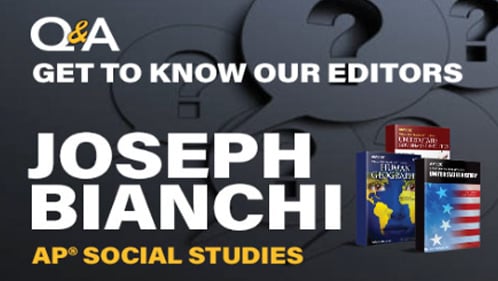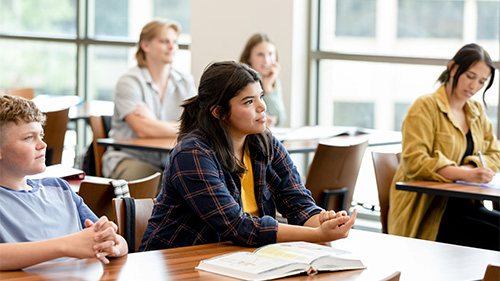AP® US History: Article Analysis
In a 2004 Gallup survey, history and social studies ranked as the least popular subject for teenagers. Why is this? Many adults recount history class...
AP & Honors Mathematics
Explore Wiley titles to support both AP and Honors mathematics instruction.
Literacy Skills & Intensive Reading
Connections: Reading – Grades 6–12
Empower student success with a proven intensive reading program that develops strong reading skills in striving readers.
Drama, Speech & Debate
Basic Drama Projects 10th Edition
Build students’ confidence and competence with comprehensive, project-based theatre instruction.
Literature
Connections: Literature
Support learners as they study dynamic, relevant texts and bring the richness of diverse voices to students through literature.
Literature & Thought
Develop critical thinking, reading, and writing across literacy themes, genres, historical eras, and current events.
Language Arts
Vocabu-Lit® – Grades 6–12
Help students build word power using high-quality contemporary and classic literature, nonfiction, essays, and more.
Connections: Writing & Language
Help students develop grammar, usage, mechanics, vocabulary, spelling, and writing and editing skills.
Reading/English Language Arts
Measuring Up to the English Language Arts Standards
Incorporate standards-driven teaching strategies to complement your ELA curriculum.
English Language Learners
Measuring Up for English Language Learners
Incorporate research-based best practices for ELLs with an approach that includes a focus on language acquisition strategies.
Mathematics
Measuring Up to the Mathematics Standards
Incorporate standards-driven teaching strategies to complement your mathematics curriculum.
Foundations
Measuring Up Foundations
Help students master foundational math skills that are critical for students to find academic success.
Science
Measuring Up to the Next Generation Science Standards
Give students comprehensive NGSS coverage while targeting instruction and providing rigorous standards practice.
Assessment
Measuring Up Live
Deliver innovative assessment and practice technology designed to offer data-driven instructional support.
For a better website experience, please confirm you are in:

One of the most common tasks I see in the social studies classroom is the use of primary sources. The power of letting people choose their own story and bringing diverse perspectives to the historical narrative is essential and worthy work. After all, teaching with textbooks, for a wide variety of reasons, turns students off, but working with letters, posters, artifacts, and speeches can liven things up.
To this end, we have seen countless curricular projects implement outstanding lessons that include multiple primary sources. Programs like Stanford History Education Group (SHEG) and The DBQ Project provide routine student experiences with documents. While these types of assignments can help students corroborate knowledge and move along the curriculum at a quick clip, it comes at the expense of deep thinking and making connections. For example, on the AP Exam, students are asked to read seven to eight excerpted documents in a 15-minute reading period. Quite simply, our students need more time to evaluate documents and make meaning of them.
As an occasional alternative, I have students pick three to four documents throughout the semester to deeply analyze in the attached graphic organizer. The benefit of this is that it allows me to provide feedback on the individual components and help assess their mastery of the historical skill on the assignment. Students need time and space to wonder, do research on the primary source, and make connections. In affording this time, students will be more likely to grapple with questions such as, “How does this source corroborate or challenge what we know?” and “Whose voices are still left out?” In doing a deep dive, students are getting closer to doing the work of historians and doing the heavy lifting of rich inquiry-based work.
The graphic organizer provided is very simple. It focuses on some of the key skills of historians: identification, argumentation, audience, historical connection, and reflection. Quite simply, we do not have the time to do this with every source one may encounter in a year-long U.S. History course. However, when we stop to ask students to connect the source to the historical time in which it was written, or the relationship between the intended audience and the writer, students are engaging in higher level tasks that will allow them to more fully understand the complex and messy work of history.
One document I frequently have students analyze in my class is a “Sharecropper’s Contract of 1867”. One point that will frequently come up in class is the very existence of a contract. Why a contract? Who does it benefit? Who does it not? Perhaps most importantly, what is the significance of marking an X on a contract? This allows students to evaluate the power dynamics of sharecropping and better understand the post-Reconstruction South. This whole class discussion and analysis would be lost if the contract was in a series of documents. Our students will do more by doing less with rich sources that lead to profound discussion, debate, and collaboration.
There are many great databases to find sources online, but for efficiency I highly recommend the source book for the textbook “Give Me Liberty” by Professor Emeritus Eric Foner of Columbia University in the City of New York. These sources are brilliantly excerpted and capture the essence of what we want our students to do: read different perspectives and make connections and reflections across historical time periods.
While coverage of content is important and meshing primary sources together has value, it is important to also let documents stand on their own. This exercise can help with deeper learning, shifting towards assessment of skills, and help students engage in the work of critical inquiry.
 Pat Sprinkle is a history teacher at the NYC Lab School for Collaborative Studies, teaching AP® U.S. History and AP® U.S. Politics and Government. Pat is a graduate of The Ohio State University and Columbia University. Pat has served as a member of the Teacher Advisory Council for the Bill and Melinda Gates Foundation, National Humanities Center, and the National Constitution Center. In addition, Pat was a 2013 James Madison Fellow along with a 2021 C-SPAN Fellow. Pat lives in Jersey City, NJ with his wife, son (Franklin), and dog (Lyndon).
Pat Sprinkle is a history teacher at the NYC Lab School for Collaborative Studies, teaching AP® U.S. History and AP® U.S. Politics and Government. Pat is a graduate of The Ohio State University and Columbia University. Pat has served as a member of the Teacher Advisory Council for the Bill and Melinda Gates Foundation, National Humanities Center, and the National Constitution Center. In addition, Pat was a 2013 James Madison Fellow along with a 2021 C-SPAN Fellow. Pat lives in Jersey City, NJ with his wife, son (Franklin), and dog (Lyndon).

In a 2004 Gallup survey, history and social studies ranked as the least popular subject for teenagers. Why is this? Many adults recount history class...

As the AP® exam draws near, students often become increasingly anxious. Review games and activities can target areas students need to review while...

Each year after the AP® exam I ask students to evaluate my class. Last year, they overwhelmingly identified that they wanted to work on FRQs more...

Early in a school year it can be a real challenge to know how to begin teaching students critical skills they need to score on the AP® U.S. History...

Discover how simulations can enhance learning in AP® U.S. Government and Politics. Engage students with hands-on activities like discretionary...

We are just weeks away from the AP® Human Geography Exam—wow! As teachers we are nervous, anxious, and hoping that we have done everything we can to...

Many teachers consider the Document Based Question (DBQ) of the AP® European History Exam to be one of the more challenging aspects of the course....

In 2015, the College Board introduced several changes to the AP U.S. History course and exam. One significant addition was the inclusion of new...

The Secondary Source Short Answer Question (SAQ) on the AP history exam presents a unique challenge: students must analyze and synthesize historical...

The art of teaching can be enhanced by storytelling and great storytelling begins with great stories. Psychology has many of these as it is the study...

Get to know one of our editors, Joseph Bianchi, who specializes in AP® Social Studies. Joe answers our questions about how he carries over his 25...

The middle of the school year is a unique crossroads for AP Social Studies teachers. The initial enthusiasm of fall has faded, the intensity of...
